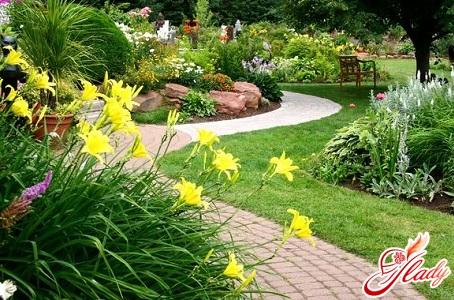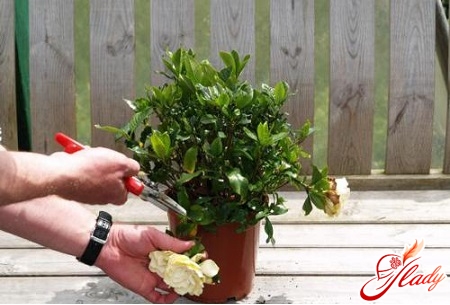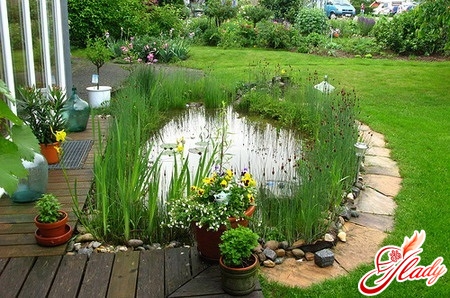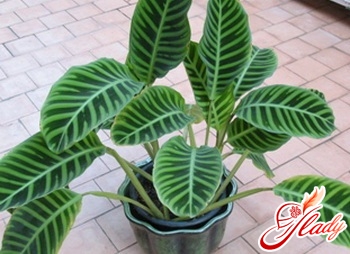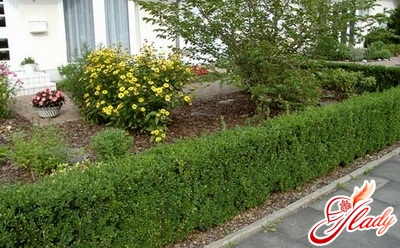 Who among us did not dream about his own lemontree? A perennial evergreen plant attracts and fascinates flower growers, despite the exacting care and the length of waiting for the first fruits. A lush spreading crown, fancy pearl flowers, fragrant and useful fruits - all this will not leave you chances to remain indifferent to the lemon when choosing a citrus culture. In our country, the most common varieties such as Pavlovsk, Maikop, Novogruzinsky. Also adapted to growing at home, the variety "Genoa", "Lisbon", "Lunario". The choice of the variety is yours, but here's what to look for when buying and how to care for the lemon at home, we'll tell in this article.
Who among us did not dream about his own lemontree? A perennial evergreen plant attracts and fascinates flower growers, despite the exacting care and the length of waiting for the first fruits. A lush spreading crown, fancy pearl flowers, fragrant and useful fruits - all this will not leave you chances to remain indifferent to the lemon when choosing a citrus culture. In our country, the most common varieties such as Pavlovsk, Maikop, Novogruzinsky. Also adapted to growing at home, the variety "Genoa", "Lisbon", "Lunario". The choice of the variety is yours, but here's what to look for when buying and how to care for the lemon at home, we'll tell in this article.
The main recommendations when choosing a lemon tree
Homeland of lemon are warm India, China,Pacific tropical islands. Therefore, the plant very, very loves light, heat and humidity. Pay attention to which side of your windows are located, and depending on this, choose the right type of lemon. In most cases, even on the south side, the lemon tree requires additional lighting. But there are varieties that can be perfectly kept on northern windows, and with a great desire to grow a healthy plant, of course, while providing artificial light and careful care. Buying seedlings of indoor lemons, focus their attention on the roots: whether they are sufficiently developed, whether the trunks on lemon seedlings are instilled in good faith. The roots of the tree should in no case remain dry, otherwise mycorrhiza (a specific mushroom deposit on the roots) will die. It is necessary that they are sprinkled with sawdust or soil. Distinguish the young shoots from the old ones by the coloring. The old leaves are dark green, dense and leathery, but the young seedlings have a light green color, they are tender in appearance and touch. The best option is to purchase seedlings from a real lover of lemon tree. He will share with you the rules of care and tell about the conditions of the plant's stay: its illumination, temperature regime, soil composition. And if you can create care with the closest possible to the necessary conditions, your tree will continue to develop well. Buy a ready-made copy in a store or with a hand - the easiest way to purchase. But to grow a lemon tree from a stone and cuttings is a more fascinating and laborious occupation. The stem will eventually grow into an adult tree, blossom and give fruits of the mother variety. The situation with the stone is more complicated. First, it will grow "wild", it is recommended to plant a piece of stalk of the necessary fruit tree. The ungrafted seedling, of course, will also bloom and even bear fruit, but there are no guarantees of the quality of these lemons. Moreover, you can receive the first fruits only after 8-10 years. However, plants grown in this way are stable and adapt more easily to changes in conditions - care for them is easier. 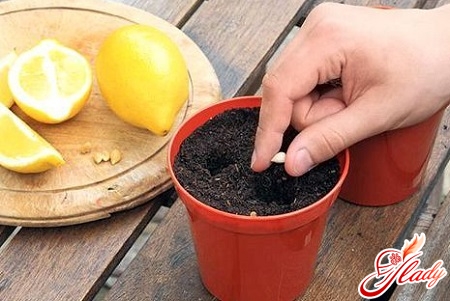
Conditions of detention
Like the whole citrus culture, lemon is betterdevelops with sufficiently bright scattered light. Direct sunlight is also harmful to the tree, as well as a lack of illumination. When the sun is intense in spring and summer, the plant needs to be shaded, otherwise there is a high probability of sunburn. Keep in mind: the growth of shoots favorably affects a long light day, but a short day promotes fruitfulness. An important condition for maintaining a lemon tree is to maintain the correct temperature. In spring, when the plant begins to grow and grow buds, one should be especially attentive to the temperature regime. Ideal for the development of buds will be a temperature in the range of +14 ... +18 degrees. At higher indices, the ovaries can dry and crumble. It will be nice to take a homemade lemon on a balcony or in a garden, but do not forget to cover or carry a tree in case of sudden temperature changes, which is typical for nature in the spring. Being on the street, your plant becomes hardened and gets used to the bright sunlight. In summer, the plant will feel comfortable both at room temperature and outdoors. But do not forget to shade the tree from direct sunlight. With the onset of the autumn, it is advisable to bring the lemon into the premises early. If the street is already cool, then the house in the warmth of the tree can bloom, and in the fall it is completely undesirable. The procedure for moving from the balcony home should also be gradual, within a week or two. For wintering the lemon, keep the air temperature no higher than 12-14 ° C with moderate humidity. Such conditions are the most comfortable for the leaves and fruits in the winter. Many plants die or cease to bear fruit because of an incorrect temperature regime in winter. Do not forget to ventilate the room, but protect the plant from drafts. In addition, watering the tree in winter, when it is already at rest, should be seldom and very carefully. You can not fill the soil, otherwise the roots can rot and the plant will die. In the spring, with intensive growth, the frequency and volume of watering increases; it is necessary to begin to fertilize the soil. For roots, breathing is an important factor, so it is necessary to periodically loosen the top layer of the soil. And for watering use warm water. A significant condition for keeping the lemon tree is the humidity of the air. Inadequate humidity is one of the main causes of plant death. To create the necessary humidity, sprinkle the spray gun as often as possible, especially in winter in a heated room. You can also use a special tray with water. Another way is to put a pot of lemon tree on a pallet with wet moss or claydite. From time to time lemons need to be transplanted. If you notice that the soil in the pot began to dry out quickly, and the roots get out from the lower hole, it's time for the lemon transplant. The best will be if you do this procedure in the spring before the shoots start growing. If the moment is lost, it is better to leave the plant alone. Root rods are very thin and tender, and it will be difficult to adapt to new soil, so there is no need to repeat the procedure annually. Inaccurate transplantation can lead to the fall of leaves and twigs, so be careful and do not damage the earthen. An important condition for proper care for a room lemon is the selection of a pot. Any opaque ceramic or clay pot with an opening at the bottom will do. The new pot should always be 2-3 fingers larger than the previous one. It is important, after repeated transplantation, to make sure that the root neck is always immersed in the soil on one level, and the base of the trunk should not be above the pot. It is also necessary to use good drainage. The soil for young plants consists of an equal amount of humus, turf, leaf land and compost. Lemon tree after transplantation must be abundantly watered, but with feeding it is worth it to wait. Fertilize the plant can be in 2-3 weeks and only after watering. Adding lemon 2-3 times a month in the first half of the summer contributes to the sweetness of the fruit and significantly reduces the bitter aftertaste. In winter, with artificial lighting, it is necessary to fertilize lemon once a week. As a top dressing use mineral and organic fertilizers. 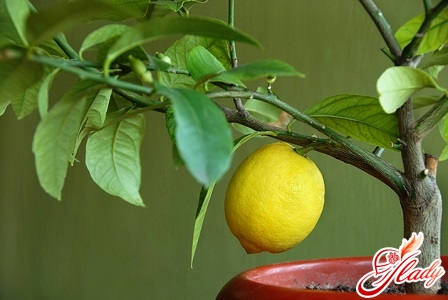
Diseases of the lemon
Since the lemon is a capricious plant and oftenis exposed to many plant ailments, knowledge in this matter is simply necessary for you. We will analyze the possible causes of room lemon diseases. Illiterate care of the plant Quite, it would seem, healthy leaves may fall due to the following reasons: poor winter coverage, high content temperature, use of cold water for irrigation, marshy or vice versa dehydrated soil. Inadequate feeding of fertilizers Note that if old leaves become mottled and gradually turn yellow, then they lack nitrogen. In the event that the leaves fade, the ends dry up to a rusty color - there is a lack of phosphorus. A small content of potassium will indicate the folds between veins. But the need for iron, manganese or zinc is expressed by a well-marked network of dark veins on a light sheet. This can also be related to soil silt in the pot. Ovary is shed - insufficient maintenance of manganese, boron. But if the ends of the leaves are dried, this means that you overfed the lemon. The defeat of small insect pests The lemon is most affected by scabbards, worms and mites.
- Shield
Lemon leaves often appear from belowround brown balls - this is an adult parasite, sucked tightly to the veins of the leaves. They have a hard shell that is resistant to chemical preparations. In case of a small lesion, the scabbard should be removed with a cotton soap disk and rubbed with alcohol. However, this will not save the plant from microscopic larvae. For the complete healing of lemon, the use of insecticides is necessary. The tree in the neglected stage is likely to not be preserved, the scabbards reproduce quickly, and the lemon gradually dries up.
- CEREBRAMS
Similar pest, but capable of ruiningthe plant is much faster. The methods of combating the worms are the same as in the case of a scabbard. To begin with, it is recommended to clean the leaves of the worms or scabbards with soapy water several times, then spray the diseased plant with a solution of soap (4 g) and anabasine sulfate (2g). It is necessary to repeat the procedure in a week.
- Aphid
In case of defeat of lemon tree aphids orwith a scabbard can be used garlic infusion. Purified garlic must be crushed and infused in water for 24 hours. The leaves of the plant are either washed or sprayed with a soap solution from the spray.
- Ants
Sometimes a lemon can clothe ants. In such a case, it is necessary to sprinkle the top layer of soil with an insecticide "Dust DDT", and the trunk to whiten chalk.
- Spider mite
A barely noticeable red spider. At a neglected stage, a spider web is noticeable. The lemon is affected mainly at low humidity and high temperature. On the leaves appear yellow, then brown spots. The main method of controlling ticks is spraying with sulfur. With an excess of sulfur on the surface of a moist soil, jumping pests - paduras - may appear. Eliminate them can be powdered from Persian chamomile. Not often, but earthworms appear in the earth. This occurs with abundant watering and soil silt. Change the care: loosen the soil for better circulation of air and pour water with potassium permanganate. After the worms come out on the surface, they need to be removed. Keep in mind: using spraying with insecticide, the surface of the ground should be covered with paper or cloth. And, of course, you can not spray buds, flowers and fruits with poisons. Infectious Diseases
- Gommoz
Usually, the disease manifests itself in waterloggingsoil, the use of cold water for irrigation, an overabundance of nitrogen and too deep lemon planting. A crack forms in the lower part of the trunk, from which a viscous dark liquid flows - a gum. The crack gradually grows and rotes, the bark dies. What to do? As a rule, the tree can not be healed. You can try to clean the cracks from rot, work with a solution of copper sulfate and transplant into a new soil.
- Black fungus
The leaves, and then the branches, envelop the darkmold deposit. Especially quickly the leaves are affected, already covered with excreta scutes and chervetsa. It is necessary to wipe the plaque on the leaves and trunk with a cloth moistened with copper sulfate or Bordeaux liquid. And do not forget to ventilate the room. Prevention of diseases Of course, it is not a secret that prevention is the best cure for diseases:
- Strongly recommended every weekarrange a water shower a room lemon, before covering the pot with the ground. It will not be superfluous to alternate the treatment with plain water and soapy water.
- New young plants should be carefully examined for diseases and pest damage. Never put immediately next to other colors. Quarantine - 2-3 weeks.
- Daily carefully inspect your pet, look under the leaves, inspect the soil.
- Periodically, every 1.5-2 months, spray the tree with manganese solution or Bordeaux fluid.
Properly growing lemon, take care ofaesthetic beauty of the tree. Initially, form a beautiful crown. Avoid single-face species. Even at an early stage of development, pinch the tips of the seedlings to stimulate the growth of lateral branches. If your goal is to get useful fruits, activate flowering with additional gadgets: phytolamps, air humidifiers, etc. In the places of origin of lemon - on tropical islands - the trees begin to bear fruit after 5-6 years. In room conditions it all depends on the conditions of detention. The more approximate conditions you create, the earlier you get real home lemons. Now you have a general idea of how to care for your home lemon, and finally one more important and most important condition is your love and interest in the plant. And the reward to you will be a real lemon garden with exotic flowers and useful fruits.




